UK: The first viaduct section on HS2’s triangular junction outside Birmingham has been unveiled. Chris Howe reports from the site in Warwickshire.
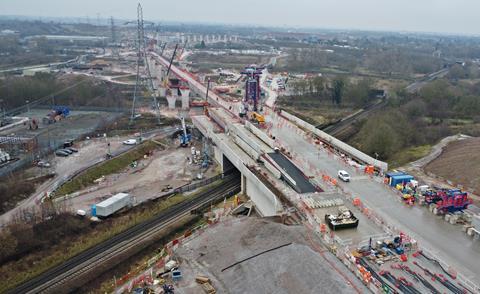
The Balfour Beatty-Vinci joint venture that is building the West Midlands section of High Speed 2 has revealed the first completed viaduct section that will form part of a series of structures which is collectively referred to as Delta Junction.
The triangular-shaped junction in North Warwickshire will take trains from HS2’s north-south main running line west towards Birmingham, while potentially allowing passenger trains to operate from Birmingham to northwest England and Scotland.
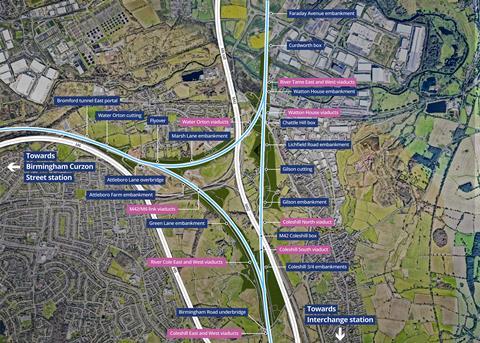
The completed segment unveiled by the contractors on February 12 is a 472 m long single track deck forming part of the River Tame West viaduct. Located at the northern tip of the triangle, this is one of three separate River Tame viaducts that converge at Curdworth Box. Two further viaducts, Water Orton East and Water Orton West, will take the HS2 tracks from the north towards Birmingham.
Curdworth Box itself is formed of three separate bridge decks. Together, these will take the HS2 tracks over Network Rail’s Derby – Birmingham main line. The main span will accommodate four tracks, while the two eastern spans will each accommodate a single track.
Heading north from Curdworth, the HS2 tracks towards Lichfield then become a double-track alignment before reaching the Marston box; this crosses the M42 to the west of Kingsbury. The deck for this box was constructed using 25 m long precast concrete beams that were lifted into place during three weekend-long blockades which took place in August and September 2023.
Novel construction technique
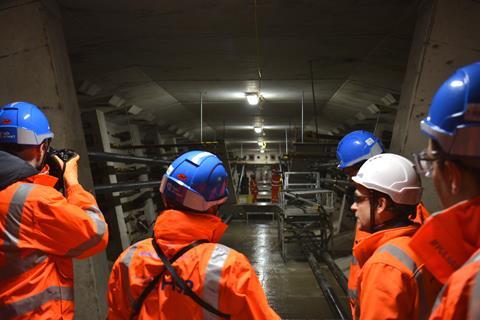
Overall, Delta Junction will require the construction of 13 viaducts. In all, 2 742 deck segments will be manufactured for the various Delta Junction viaducts, of which 59% have so far been produced at a factory in Kingsbury.
Nine of the viaducts will be erected using a technique that the contractor says has never been used before in the UK. BBV is using a mast and swivel crane to create a temporary deck assembly. The central mast is used to hold stay cables which are connected to precast concrete deck segments as they are installed. The swivel crane can then lift and position each of the segments, which can weigh up to 80 tonnes. The crane then holds the segment in place while stay cables and temporary tensioning bars are installed within the segments.
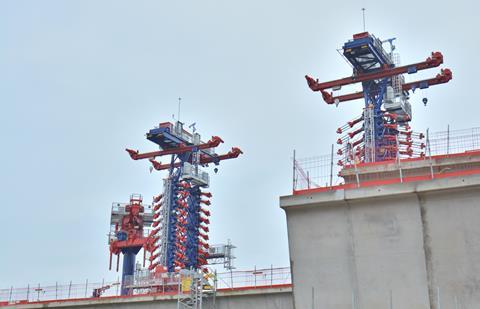
The stay cables and bars hold the segments in place during construction, initially forming a cantilever structure. Once all of the segments for each 45 m long span have been installed, permanent strands are threaded through the segments, which are then tensioned to hold the span together. Once the permanent post-tensioning has been completed, the temporary bars and stay cables are removed which leaves the 45 m long post tensioned box girder ready for commissioning.
The cantilever methodology was first developed by engineering firm Campenon Bernard, which later became part of Vinci Construction. The masts and swivel cranes have been designed and manufactured by BERD. Although BBV reports that this method has never been used in the UK before, similar systems have been successfully deployed on other projects around the world.
A total of 136 spans will be constructed using the cantilever method, while another 11 will use a ‘side span’ support system, with a further six spans are to be pre-assembled and moved into position using self-propelled modular transporters.
Operational uncertainty
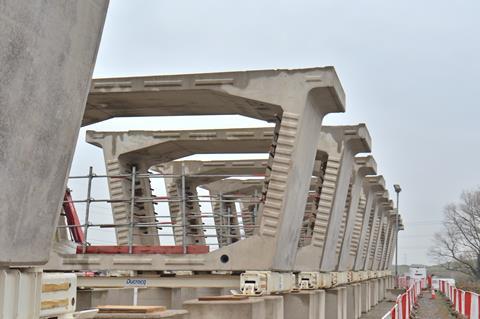
The scale and complexity of Delta Junction is difficult to convey. BBV is essentially building three distinct grade-separated junctions. This will involve crossing rivers, motorways, other main roads and existing railways. A major obstacle is the sprawling highway intersection which connects the M6 link road with the M6 Toll and the M42, which means the two Water Orton viaducts must span 11 traffic lanes below.
Given the major descoping of HS2 that has been announced over recent years, there are questions to be answered about how the Delta Junction will support the operational railway as currently designed. The west-to-north curve of the junction in particular is not expected to see any revenue-earning trains once HS2 opens in the early 2030s.
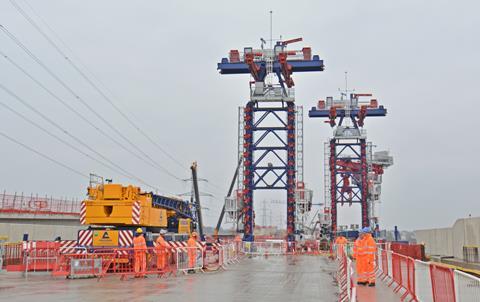
The southern curve will be used by trains between London and Birmingham, but there is as yet little clarity on the plan to connect HS2 to the West Coast Main Line If the current plan for a connection at Handsacre Junction near Lichfield is retained for the longer term, trains between Birmingham and the north would only use dedicated high speed infrastructure for a very short distance before joining the WCML, which could limit its attractiveness commercially and operationally.
Nevertheless, Delta Junction is future-proofed to allow services to potentially operate between Birmingham, northwest England and Scotland if HS2 is extended beyond Handsacre in the future.



